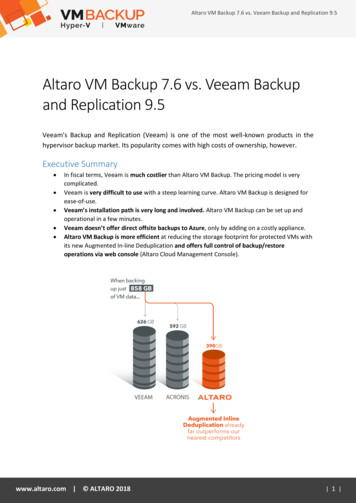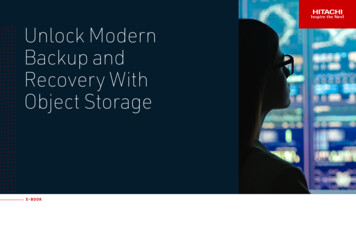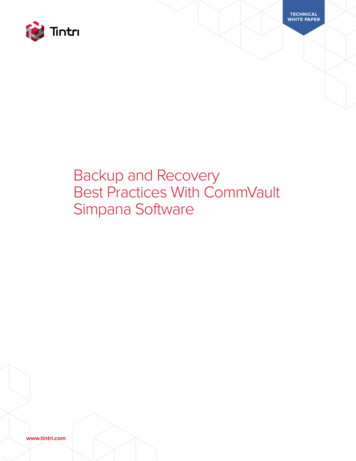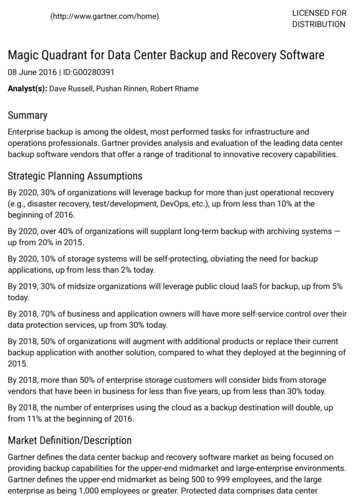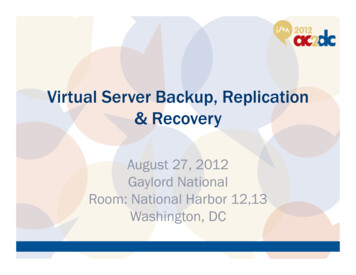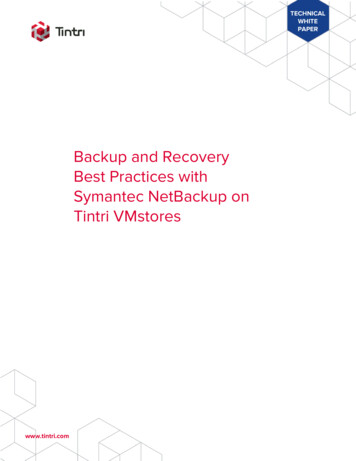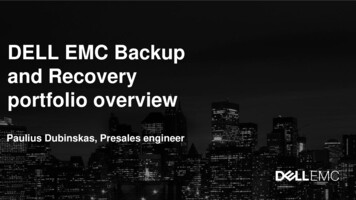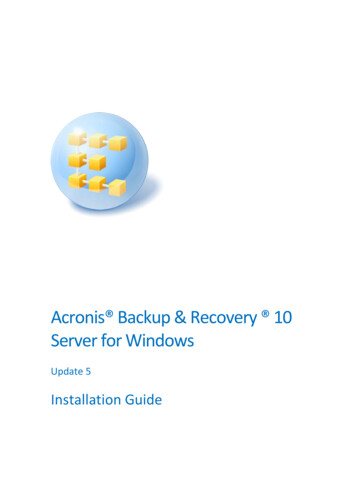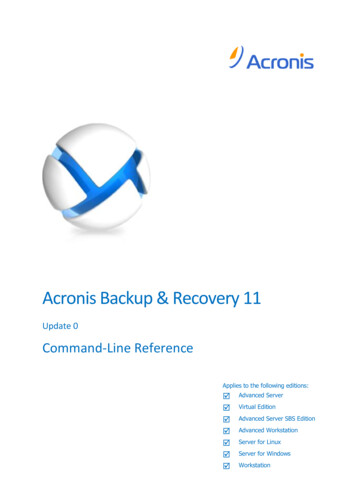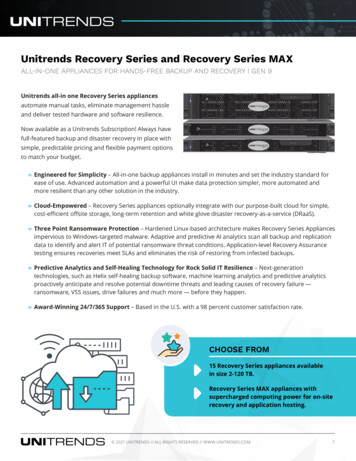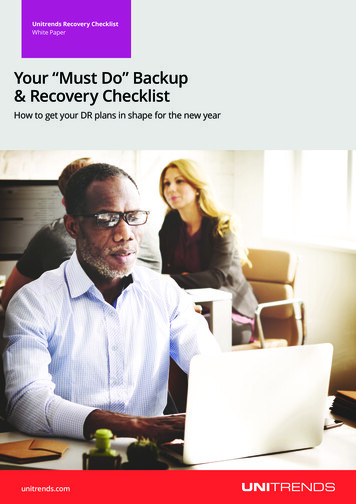
Transcription
Unitrends Recovery ChecklistWhite PaperYour “Must Do” Backup& Recovery ChecklistHow to get your DR plans in shape for the new yearunitrends.com
Unitrends Recovery ChecklistWhite PaperYour “Must Do” Backup& Recovery ChecklistHow to get your DR plans in shape for the new yearHow to Get Your DR Plans inShape for the New YearA new year or a new quarter is a natural time to take stockof business continuity and recovery assets and evaluatewhat areas need improvement. Data is the lifeblood ofall enterprises and a valuable asset that requires havingefficient processes in place to ensure the business canaccess critical systems in a timely fashion. It’s time to reviewcritical backup and recovery plans and determine if theymeet your company’s specific requirements for uptimeRecovery Time Objectives (RTOs) and Recovery PointObjectives (RPOs) as well as your compliance Service LevelAgreements (SLAs).systems, multiple hypervisors and in the cloud. All of this isa must while also attempting to assure 24/7 access to criticalapplications.The Current State ofData RecoveryIn review, a TechTarget survey1 showed that nearly one-third(30%) of organizations were using cloud storage servicesand almost half (48%) were planning to add more or startincorporating cloud into data protection solution. Backup(62%) is still the primary application for those using cloudstorage. The fastest growing use cases were disasterrecovery (35%) and archiving/long term data retention (35%)to meet compliance and regulatory requirements.However, concerns continue to challenge cloud storageadoption, including security, with 54% saying that theystill worry about how their data is handled and managedin the cloud. The expectation that all company data andapplications will be available at all times, from any locationYour IT organizations is likely continuing to seek new waysto leverage virtualization and cloud computing servicesto better meet rapidly evolving business needs. While ITfocuses on transforming the data center, updating dataprotection and recovery strategies become increasinglycritical. Often-times, existing data protection and recoverystrategies prove unsuitable or are not optimized for newproduction, data growth, and compliance requirements.An outdated disaster recovery solution could add layersof complexity and cost and make it frustrating to meetbusiness continuity demands.These and other important trends are converging to createchaos and great change for businesses across all industries.If you’re not already, you’ll soon be challenged to recovergrowing data assets faster while also managing applicationsrunning across hyper-converged systems, multiple operatingunitrends.comand any device, continues to grow. Substantial growth incyber-attacks, data breaches, and new viruses increasethe risk of data loss and continue to be of great concern.Combine these concerns with exponential data growth, newcomplex applications, increasing compliance and regulatoryrequirements, and the need to strengthen disaster recovery(DR) resources rises significantly. Add the threat of floods,fire, major storms, and other external forces and a shadowis cast over IT resiliency that can only be safeguarded byimplementing a robust DR strategy.With growing challenges and emerging technologies, sortingout the real trends from the noise can be confusing. Takea look at the current trends in DR and backup that may helpreduce the stress of making the right decision to -buying-in
Unitrends Recovery ChecklistWhite Papercost-efficient disaster recovery andyour data to get started. “Reversebusiness continuity in the coming year.Seeding,” a.k.a. a Data ShipmentService Level Agreement, allowsBackup and DR Trendscompanies to get data back within 24Variations in cloud backup andhours in the event of a disaster. If therecovery solutions will continue togrow.There are wide variations in cloudoptions so IT leaders must do theirhomework before deciding whichsolutions are the best fit for theircompany’s environment. At first glance,it may appear that the obvious solutionis to simply move copies of backupsto a hyperscale cloud vendor. Withthe cloud storage cost per GB as lowas one cent per month with somehyper-scale cloud providers, that mayseem like the most affordable option.For some companies, it’s the rightchoice. But IT leaders must look at thetotal cost of each solution, includingnetwork egress fees, data retrievalcosts, and the compounding storageof data for long-term retention. ITprofessionals may be shocked bythe total costs for these low-costoptions over a period of a few years.Additional factors such as the ability toget the data back quickly may not beso obvious and can be just as costly.There are also wide variations in theSLAs that the various solutions providefor uptime, guaranteed recovery times,etc.There is also diverse functionalitybetween vendors. Many cloud recoverysolutions have simply taken existingbackup techniques and bolted on acloud extension. In other words, theyhave created a mechanism to movecopies of backups to offsite cloudstorage that previously would havebeen stored locally, or put on tapesand shipped to a vault. While thissolves some problems by automatingunitrends.comformerly manual processes of movingdata offsite for basic archiving, thosesolutions may not provide true DR oroperation in the cloud in the event of afull primary site failure. Therefore, duediligence is required when comparingoptions.customer has a disaster and loses all ora large amount of their data, the cloudvendor places their data onto disks ora new backup appliance and ships itto the customer. A data shipment SLAcan be the difference in having a RTOof hours vs. weeks for large amountsof data.WAN bandwidth concerns persist.Storage growth continues unabated.There is more data than ever to backup. However, while wide area network(WAN) bandwidth continues to grow,it remains a tremendous challengemoving data in hybrid cloud continuityarchitectures.As a result, it’s extremely important touse granular continuity approachesthat can mix local archiving withadvanced WAN accelerationtechniques. More than ever, whatmatters is the backup and dataretention solution’s ability to efficientlydeduplicate, compress, and otherwiseoptimize the amount of backup datathat needs to be sent over the WAN.There is an alternative method to getthe initial set of data into the cloudwithout having to wait days or weeksto transfer many TBs over a WAN.This method is seeding. Seeding usesphysical disks and overnight shippingto quickly create the first dataset inthe cloud. Media is sent to the cloudprovider to “seed” the initial full setof data and avoid the WAN challenge.However, not all vendors offer aseeding option.Seeding can also be done in reverse,and this option may be even moreimportant than the initial seeding ofSecurity continues to be a concern.Consistently, security is the topconcern of IT regarding the use ofcloud technologies, and this trend islikely to continue. Despite the fact thatmost cloud facilities operate with farmore extensive security measures thatmost enterprise data centers, thereis natural concern among some ITand business leaders in moving datato anywhere outside of their control.In some cases, there may even be aregulatory requirement against it.To get greater confidence, IT professionals must ask cloud vendors aboutSSAE 16 and SOC compliance certifications. SSAE 16 effectively replacedSAS 70 in 2011 and is useful invalidating security and other financialreporting requirements. Additionally,data must be encrypted in flight and atrest on the cloud, preferably with AES256-bit high grade encryption.
Unitrends Recovery ChecklistWhite PaperDR will continue to evolve to keep upcan be used to rapidly spin-up criticalIncreased demand for automatedwith business demands.workloads. System availability and truetesting and validation of cloudIT strategies are changing as newDR can be done with a single click ofbackup and DR.software and cloud services area button or a phone call to declare aBackup and DR environments areadopted to meet business goals.disaster.important. However, what mattersIn this environment, it’s not justis whether the company can recoverabout storing data but using thatDisaster Recovery-as-a-Service willdata and spin up critical systems whendata for multiple workloads andcontinue to grow.needed. Unfortunately, for too manyenvironments. Therefore, we will seeAs cloud-based infrastructurecompanies, there are frequent doubtsconvergence fuel the modernizationcontinues to become the de factoabout the ability to recover. Todayof backup in the coming year. Thisstandard for businesses, servicemost DR environments are typicallywill involve streamlining how data isofferings continue to grow inonly tested every few months or oncereplicated and protected, and thesepopularity and market share. Disastera year, if at all. These manual tests cannew cloud-oriented architecturesRecovery-as-a-Service (DRaaS) willbe expensive and highly disruptive.will encompass services and service-be a game changer in 2017 as it willTrue recovery assurance solution areoriented architecture implementations.enable businesses to meet and exceednow available that can solve theseWhereas people once bought servicescustomer and employee expectationschallenges. With recovery assurance, ITand storage separately, there will bearound availability. As businesses placeno longer has to wonder if the backupsan expectation of convergence whereIT and availability at the center of theirare viable and the applications willa single application performs multipleoperations, expect to see SLAs withwork properly in the DR environmentfunctions including data protection,guaranteed backup and recovery timeswhen required. Recovery assurancebackup copy for long term retention,becoming the standard for the modernends the DR testing challenges thatdeduplication, replication, and securityenterprise.many enterprises face. Recoveryin-flight and at-rest. Cloud workloadsassurance solutions automate theand functions such as DR and testingtesting of backup and applications ininstances will also converge. Alongsidethe DR environment. By automatingthis, the management side will gettesting, IT professionals can testjoined up as well—the “single pane ofand certify, at the application level,glass” approach will allow IT to managethat critical systems are functioningand view data from multiple sources inproperly, providing IT with absolutea single display.confidence in the environments.RTOs and RPOs for mission criticalA move beyond data protection toenvironments will continue toCompliance concerns become moresystem and workload availability.shrink.critical.Once copies of backup data are in theIT professionals under pressure toEnterprises are increasingly getting hitcloud, numerous other possibilitiesmaintain business continuity arewith new compliance requirements.open up. IT leaders can begin to thinkincreasingly working to meet moreFor companies in most industries,differently about data protection andstringent RTOs and RPOs for missioncompliance regulations require reliablestart thinking about data and systemcritical systems such as databases,and provable business continuityavailability. The dynamic nature ofemail, and business-specific data.plans, including the implementationcloud resource provisioning and theConverged data protection solutionsof offsite DR protection processes. Asmobility of data and resources withinallow for the incorporation of highera result, DR is no longer an option,the cloud opens up possibilities thatperformance recovery within existingbut a necessity so that the organi-would have been far beyond thedata recovery infrastructure, thereforezation is well prepared to pass its nextreach of most companies just a fewcentralizing and reducing managementcompliance audit. Looking ahead, DRyears ago. Data stored in the cloudcomplexity.in the cloud will become a key initiativeunitrends.com
Unitrends Recovery ChecklistWhite Paperfor most organizations looking tomost severe disasters on record,included in downtime cost calculations.assure a compliant enterprise asit appears that many CIOs aren’tAn average estimate, according toit addresses the need for businesspreparing their companies for thestudies and surveys performed bycontinuity without heavy investmentsnext one. It’s crucial for IT to prioritizenumerous IT analyst firms, downtimein additional physical resources or thecustomer-facing and other business-cost businesses between 90,000 andneed to build an offsite data center.critical systems for immediate recovery 300,000 (US dollars) for every hourHybrid cloud backup and recoveryand business continuity, while certainof IT system downtime. Loss to largesolutions are emerging as a keyfile data and backed-up data (user filesfinancial institutions, telecommuni-solution to enable business continuityand archives) can be put off until later.cations, transportation, manufacturing,24x7x365. The mix of local backupThe first step of disaster preparationand energy companies can be signifi-solutions, combined with copies ofis to assess the impact of downtime.cantly higher.backups and archive in the cloud, plusIt’s imperative to understand theBeyond loss of revenue, productivity,DRaaS and recovery assurance caneffect of downtime cost on theand reputation, businesses todayempower a company with absolutebusiness. Unexpected IT outages cancannot function without computerconfidence to withstand almostunleash a series of direct and indirectaccess and functionality. FEMA reports2any downtime event or disaster. Toconsequences both short-term andthat most businesses that sufferdetermine the most appropriatefar-reaching. The dollar amount thatcatastrophic data loss or an extendedplan and course of action, we firstis assigned to each hour of downtimeIT outage go out of business within twoneed to understand the real cost ofvaries widely depending upon theyears of the disaster.doing nothing in today’s always onnature of the business, the size of theenvironment.company, and the criticality of theNo matter what the cause, downtimefailed IT system to primary revenueimpacts more than day-to-daygenerating processes.interactions. It can impact the integrityThe following chart includes bothof databases as well as the applicationsdirect productivity and revenue loss asthat use them. Some businesseswell as indirect cost such as damagecan survive some data loss, whileto reputation, loss of customerothers are dependent on electronicopportunity, and damage to thedata interchange, or are required tocompany brand. When calculating2The High Cost of NotHaving a DR Planloss, each of these factors should beProtecting Your Business” June 15,2015 n information and communication systems are disrupted, it’s muchmore than an inconvenience. Digitalrecords and legal documents can beProductivity Number of employeesaffected X hours outtimes X burdened hourlyratelost, employee and customer trust canbe weakened, and productivity andrevenue can be threatened severely.As we have seen during events such asnatural disasters, situations that shutDamaged Reputation Customers Suppliers Financial Markets Banks Business Partners Know your downtimecosts per hour, day,two days.down business-critical systems andapplications for any length of time (orwipe them out completely) can havedevastating direct and indirect coststo the business—costs that make itOther Expenses Temporary employees,equipment rental, overtimecosts, extra shipping costs,travel expenses, legalobligationsabsolutely vital to have a solid DR plan.But even in the wake of some of theunitrends.comFigure 1: Know Your Downtime CostsRevenue Direct loss Compensantory payments Loss future revenue Billing losses Investment lossesFinancial Performance Revenue recognition Cash flow Lost discounts (A/P) Credit rating Stock price
Unitrends Recovery ChecklistWhite Paperarchive information to meet stringentWhen establishing priorities, Businessproductivity, but the organizationaudit, regulatory, and complianceContinuity needs to be understood.can continue to operate, so theserequirements. Businesses that employSometimes, even while certain ITapplication may be of lower recoverya global workforce that collaboratesystems are down, the businesspriority in the middle of a disaster.around the clock, or provideneeds to continue to operate criticalEvaluating potential risk and theeCommerce to make sales and deliverapplications via alternative processesimpact on each application or servicecustomer service 24/7, also cannotand or locations for reasonableis key to understanding the organiza-afford data loss. While all organizationsperiods of time.tion’s needs and providing a differen-feel the impact of IT system downtime,The most important step in disastertiated level of service availability basedorganizations that rely on real-timerecovery planning is to understandon business priority. With more datadata dependency will suffer most fromhow an unplanned outage can affectand services on premises and in thethe effects of any downtime, bothan organization. Without the abilitycloud, businesses need to ensure theyimmediately after the data loss andto determine impact of an unplannedhave strategies to backup, protect, andwell into the future.outage in a meaningful way, itrestore their data on all fronts. Whatbecomes very difficult to determinefollows are some important steps toAs an IT professional, it’s inevitablethe type of disaster recovery strategyensure your backup and recovery planthat you will one day experience aneeded. The greater the potentialis in shape for the coming year.system failure, outage, or completeimpact, the more important it is tosite disaster. Your organization mayimmediately restore an application oralready have a full or partial DR planservice. Include the following in yourcompleting within allottedin place, but are you certain youimpact analysis:timeframes required to meetcertain you can recover your criticalapplications and data in a timelymanner that meets corporate businesscontinuity requirements and customerexpectations? Now is the right time toreview your priorities and ensure youare on the right path to recoveringdata and applications to meet your Take an inventory. Ensure allbackups are automated and What applications and data doesbusiness recovery and operational your operation use?requirements. Be certain that theWhat is your tolerance for downtimeentire environment (all physicalfor each application?and all virtual) are protected by aWhat is your tolerance for data losssingle application and with a singlefor each application?management console, eliminatingWhat dependencies (databases,cost and complexity. DNS, Active Directory, Web Review and rank the most criticalbusiness needs.Services, etc.) are needed for eachPriorities: A Checklist for Startingon the Right Pathapplication?are essential to keeping businessWhat are the regulatory andoperations running? How docompliance requirements (internalthe applications differentiateand external) for data retention, andthe business from others in thefor how long?segment? Next, look at the applica-A disaster just isn’t what it usedto be. In years gone by, mostcompanies defined a disaster as anact of nature—a hurricane, tornado,flood or fire that ravaged a buildingand wiped out a company’s abilityto conduct business. Today, withworldwide networks, Web apps, and24/7 call centers, even a commonelectrical failure could spell disaster ifit brings communications and onlinetransactions to a screeching halt.unitrends.comapplications. Which applicationsEach application and service has ation’s data volatility. Those with thespecific function and needs to behighest rate of churn or changeprioritized. Some are more time-sen-(e.g., online trans
SSAE 16 effectively replaced SAS 70 in 2011 and is useful in validating security and other financial reporting requirements. Additionally, data must be encrypted in flight and at rest on the cloud, preferab

